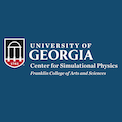Events Calendar View
-
CSP Lunch Seminar
Sep 20, 2016
Density functional theory studies of dopant effects on photo refractive potassium niobate

Guest: Eric Suter, Center for Simulational Physics, University of Georgia
Tuesday, September 20, 2016 12:30 pm - 1:30 pm
Location: CSP Conference Room (322) -
Departmental Colloquium
Sep 22, 2016
Quantum Computing with Trapped Ions
Quantum computation promises an exponential algorithmic speed up over classical computation. Currently quantum computing hardware is limited by errors in the control and unwanted interactions with the environment. I will present our theoretical and experimental work on removing both control and algorithmic errors in ion trap quantum processors. I will also discuss proposals for scaling ion trap quantum computers from 10's to 100's of qubits. -
CSP Lunch Seminar
Sep 27, 2016
Density functional theory studies of dopant effects on photo refractive potassium niobite - Part II

Guest: Eric Suter, Center for Simulational Physics, University of Georgia
Tuesday, September 27, 2016 12:30 pm - 1:30 pm
Location: CSP Conference Room (322) -
Departmental Colloquium
Sep 29, 2016
A Golden Lesson from Nature: The Origin of Nonequilibrium Surface Roughening in Thin Film Growth
Nature has given us tremendous inspirations since the beginning of the human civilization. Scientific progress has resulted often when new experiments have directly contradicted a well-established and verified theory. In this talk I will discuss an example of how progress was made in understanding the growth of thin films by molecular beam epitaxy when a seemingly paradoxical challenge was presented to existing theories that had been developed over a period of more than three decades. I will present an overview of the problem and how theory, simulation and experiments all played an important role in resolving this challenging problem. -
CSP Lunch Seminar
Oct 4, 2016
Theoretical approaches for multi-electron Auger process. Some progresses on the theoretical investigation of charge transfer process for atoms and molecules.
-
Departmental Colloquium
Oct 6, 2016
Unlocking the Potential of Multiply-Charged Ions
In this talk I will discuss multi- to highly charged ions, and the broad range of physical problems, both fundamental and applied, where they appear. This will include an introduction to the Clemson University Electron Beam Ion Trap (EBIT) laboratory, where you can gain local access (less than 120 km from Athens-to-Clemson) to multiply charged ions, an otherwise unique form of matter common to the universe at large but extremely rare on Earth. As a historical tool, EBITs were designed for ground-based spectroscopy, as they provide one of the few ways of controllably testing astrophysical models in a tunable environment while probing atomic structure along the way. This interest in terrestrial astrophysics has led to the development hybrid EBITs as ion sources where extracted “beams” of ions are used to study gas, dust and ice interactions and provide data for modelling charge exchange and hollow atom decay processes. While EBITs owe their design to this astrophysical connection-to-reality, they have also opened the door for curiosity driven materials studies that have revealed unique "hillock" structures formed by ion impacts and they have led to new technology areas in modified materials, surface cleaning, self-guiding capillaries, and single ion implantation.
Page 68 of 121, showing 6 records out of 723 total, starting on record 403, ending on 408


